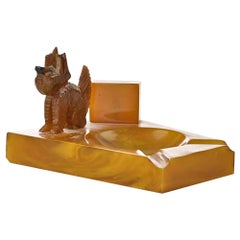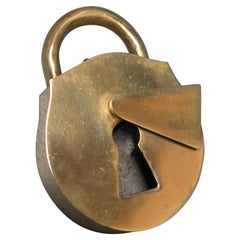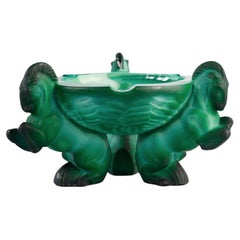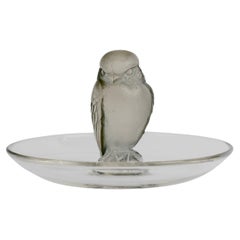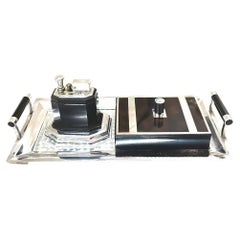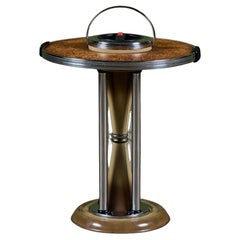1930s Ashtrays
to
14
75
6
21
2,285
201
110
1,327
622
5
2
35
75
57
245
343
331
54
11
56
2
2
1
39
34
22
7
7
27
18
60
25
14
8
8
75
75
75
2
2
1
1
1
Period: 1930s
Vintage Amber Bakelite Art Deco Ashtray, 1930s
Located in Roma, IT
Vintage Amber Bakelite Art Deco Ashtray, realized in 1930s.
Excellent condition.
Category
European Vintage 1930s Ashtrays
Materials
Bakelite
Carl Auböck Brass Ashtray, Model 3317, Austria 1935
Located in Den Haag, NL
Carl Auböck brass ashtray, model 3317, Austria 1935.
Category
Austrian Mid-Century Modern Vintage 1930s Ashtrays
Materials
Brass
Art Deco Bohemian Curt SCHLEVOGT Malachite Glass Ashtray, 1930s
Located in Lucenec, SK
A stylish Art Deco Czech green malachite glass ashtray supported by three rearing ponies attributed to Schlevogt and dating from 1930s-1940s. The rounded ashtray has a recessed polis...
Category
Czech Art Deco Vintage 1930s Ashtrays
Materials
Malachite
1931 Rene Lalique Astray Pintray Rapace Bird Glass with Grey Patina
By René Lalique
Located in Boulogne Billancourt, FR
Ashtray Pintray "Rapace" made in molded glass with grey patina by Rene Lalique in 1931.
Stamped signature on bottom.
Perfect condition.
height : 6 cm
diameter : 12 cm
Félix Ma...
Category
French Art Deco Vintage 1930s Ashtrays
Materials
Blown Glass
1935 ArtDeco Smokers Set Tray, Cigarette Case w/ Lighter by Ronson
By Ronson
Located in Van Nuys, CA
The 1935 Art Deco smoker's set includes a chromed tray with a chromed and black lacquered Desk Box with an Octette Touch Tip Lighter by Ronson.
This desk box features a sleek, black...
Category
American Vintage 1930s Ashtrays
Materials
Steel
$765 Sale Price
40% Off
Art Deco Free Standing Ashtray
Located in Los Angeles, CA
Art deco free standing ashtray c.1930s, USA. It features a wood laminated table top and stainless steel chrome body. The ashtray has a red button...
Category
American Art Deco Vintage 1930s Ashtrays
Materials
Stainless Steel, Chrome
Murano, 1930, Italian. , Technique: Bullicante Attributed to Carlo Scarpa
By Carlo Scarpa
Located in Ciudad Autónoma Buenos Aires, C
Murano
Technical Bullicante
Attributed to Carlo Scarpa
We have specialized in the sale of Art Deco and Art Nouveau and Vintage styles since 1982. If you have any questions we are at...
Category
Italian Art Deco Vintage 1930s Ashtrays
Materials
Murano Glass
French Art Deco Brass Ashtray
Located in Los Angeles, CA
Art Deco Brass ashtray original condition from the Art Deco period .
Category
French Art Deco Vintage 1930s Ashtrays
Materials
Bronze
Pierre d'Avesn at Verlys Art Deco Ashtray, Late 1930s
Located in Saint-Amans-des-Cots, FR
This exquisite ashtray is a stunning example of French Art Deco design, created by Pierre D'AVESN for VERLYS, Les Andelys, France, in the late 1930s. Crafted from thick molded glass,...
Category
French Art Deco Vintage 1930s Ashtrays
Materials
Glass
Art Deco Pierre D'Avesn Molded Glass Bowl France 1940 transparent Color Signed
Located in Auribeau sur Siagne, FR
This vide poche or ashtray in in Glass. It has been done circa 1940, in France.
Transparent Color.
Original and iconic molded glass bowl; its shape is simple and decisive, skillfully...
Category
French Vintage 1930s Ashtrays
Materials
Glass
$335 Sale Price
20% Off
Art Deco Mobil Gas Pegasus Executive Ashtray
Located in Red Lion, PA
1930's Art Deco Mobil Gas Pegasus Metal Ashtray
This striking 1930s Art Deco metal Mobil Gas Pegasus ashtray is a fantastic piece of vintage advertising and design. The sculptural form showcases a beautifully detailed Pegasus in mid-flight, dramatically rising from a rugged cliffside. Cast entirely in metal, the piece is both functional and decorative, with a wide ashtray base and its original felt bottom, which remains intact despite some expected wear.
During the early 20th century, ashtrays were a popular form of advertising merchandise, particularly in the 1930s and 1940s, when companies sought to incorporate stylish and durable branding into everyday objects. The Mobil Pegasus...
Category
Art Deco Vintage 1930s Ashtrays
Materials
Metal
French Art Deco Bronze Sunburst Ashtray or Dish, 1930s
Located in Esbjerg, DK
A rare solid bronze dish or ashtray depicting a Helios sun disk -bursting sun - au Soleil d'or. It was made in France circa 1920-40. It has no markings. t has a rich and deep natural...
Category
French Art Deco Vintage 1930s Ashtrays
Materials
Bronze
Danish Bronze Ashtray with H. C. Andersen 's 'The Pig Boy', 1930s
Located in Esbjerg, DK
Bronze relief dish or ashtray displaying a scene from H. C. Andersen Fairy Tail 'The Pig Boy'. Made by Cawa in Denmark during the 1930s. Marked to its base: Cawa, Denmark 'Svinedreng...
Category
Danish Victorian Vintage 1930s Ashtrays
Materials
Bronze
$263 Sale Price
20% Off
Art Deco Highly Stylized Cubist and Geometric Teal Green Dog Ashtray
Located in Red Lion, PA
Rare Art Deco Teal Green Metal Dog Ashtray – Geometric & Cubist Design, Original Paint
This highly stylized Art Deco metal ashtray is a striking example of early 20th-century design...
Category
American Art Deco Vintage 1930s Ashtrays
Materials
Metal
Swedish Modern Ystad Metall Ulla Fogelklou-Skogh Brass Ash Tray 1940s
Located in Boden, SE
Ash tray by Ulla Fogelklou-Skogh for Ystads metall Sweden
Swedish 1940s brass.
Category
Swedish Scandinavian Modern Vintage 1930s Ashtrays
Materials
Brass
Frankart Copper-Tone Nude “Sarcophagus Girl“ Figural Cocktail Smoker
By Frankart
Located in Van Nuys, CA
Frankart company figural “Sarcophagus Girl“ metal ashtray stand featuring a nude women holding up the ashtray stand standing on a stepped art deco base.
...
Category
American Vintage 1930s Ashtrays
Materials
Spelter
$1,500 Sale Price
40% Off
French Art Deco Brass and Cobalt Blue Glass Ashtray with Bellboy Figure, 1930s
Located in Dublin 8, IE
French Art Deco Brass and Cobalt Blue Glass Ashtray with Bellboy Figure, 1930s
This unique French Art Deco ashtray is a striking combination of form and function, dating from the 19...
Category
French Art Deco Vintage 1930s Ashtrays
Materials
Brass
Art Deco floor ashtray made of brass and copper. Italy, 30s
Located in Torino, IT
Floor ashtray
Art Decò
brass and copper.
ORIGIN
Italy
PERIOD
1930s
MATERIALS
Brass and copper
DIMENSIONS
Height: 57cm
Ø 21cm
CONDITIONS
The piece is in excellent condition, as c...
Category
Italian Art Deco Vintage 1930s Ashtrays
Materials
Brass, Copper
Murano, 1930, Italian. Attributed to Paolo Venini Technique Pelegoso
By Paolo Venini
Located in Ciudad Autónoma Buenos Aires, C
Murano
We have specialized in the sale of Art Deco and Art Nouveau and Vintage styles since 1982. If you have any questions we are at your disposal.
Pushing the button that reads 'View All From Seller'. And you can see more objects to the style for sale.
Venini ( Technique Pelegoso )
Pelegoso technique A type of glass characterized by countless irregular air bubbles (pulighe) within the vitreous wall, which deliberately obscure its transparency. It is obtained by pouring substances such as petrol into the pot, which produce a boiling over of the glass in fusion.
Attributed to Venini
Early life and education
Venini was born in the town of Cusano near Milan, Italy. After serving in the Royal Italian Army in World War I, he trained as a lawyer and began his practice in Milan. He soon developed an acquaintance with Giacomo Cappellin, a native of Venice who owned a Milan antiques...
Category
Italian Art Deco Vintage 1930s Ashtrays
Materials
Murano Glass
Italian Futurism Ashtray for La Rinascente by M.G.A, 1930s
Located in Milan, IT
Italian Futurismo Ashtray for the Italian department store La Rinascente
by Nikolay Diulgheroff for M.G.A, 1930s
Category
Italian Art Deco Vintage 1930s Ashtrays
Materials
Ceramic
Art Deco Nude Woman Seated at Pool Bronze & Crystal Sculpter Ashtray by Nuart
By Nuart
Located in Van Nuys, CA
A Stunning Art Deco figural female nude gracefully sitting by a pool with a crystal glass ashtray by NuArt Creations. This spelter metal sculptural featuring an elegant bronze finish...
Category
Vintage 1930s Ashtrays
Materials
Crystal, Bronze
$390 Sale Price
40% Off
Murano and gold, Italian, Attributed to, Seguso Barovier, 1930
Located in Ciudad Autónoma Buenos Aires, C
Murano
We have specialized in the sale of Art Deco and Art Nouveau and Vintage styles since 1982. If you have any questions we are at your disposal.
Pushing the button that reads 'View All From Seller'. And you can see more objects to the style for sale.
The history of "Seguso Vetri D' Arte" is directly linked to the "Vetreria Artistica Barovier" company. When the Barovier workshop was forced to reduce production in 1929, due to a financial crisis in America, the
original group of ten partners had to separate and Antonio Seguso in 1931, assisted by his sons Ernesto and Archimede opened a small workshop of his own. They were joined by Luigi Olimpio Ferro and Napoleone Barovier the following year. Together the craftsmen establish the "Artistica Soffieria e Vetreria Barovier Seguso & Ferro" company as equal partners.
In 1934 Flavio Poli joins the firm as artistic director and within only a brief period of time a distinct style of designs emerged. The close collaboration between Flavio Poli, Archimede Seguso and Alfredo Barbini played an important part in the success of the company. New glass techniques are developed which include never before seen color applications.
The companies innovative designs constantly received awards and during the 1935 World Fair in Brussels and the 1936 Milan Triennale they did attract the interest of a new group of clientele. One of them is the French wholesale company "Veronese" from Paris which would play a defining role in the history of the company.
The demand for an increase in production requires additional investments and the partners felt that there is a need to multiply their investment tenfold.
Luigi Olimpio Ferro subsequently decided to withdraw from the company and his shares are acquired by Flavio Poli, which makes him a full partner. As a result, the company name is changed to Seguso Vetri D’ Arte and it is officially recognized in 1937. A period of great success and prosperity ensues, lasting until the outbreak of World War II.
The post war period is a time of great change in Europe and the rebuilding of the economical structure in Italy requires major investments which result in the introduction of new import duties and taxes.
To safeguard the copyright of the Seguso Vetri D'Arte designs an application for a second entry into the commercial registers of Venice is made by the partners in 1945.
Strict export regulations curb international business relations for many years after the war and the company decides to focus on the domestic market instead. In 1946 a large retail location is opened at the Piazza Diaz in Milan where in addition to the art glass, German porcelain and Italian pottery is offered.
In 1950 Flavio Poli develops a new sommerso glass technique, which consists of an overlaying of transparent layers of glass. The overlapping creates new shades of color which prior to the introduction of this technique had not been seen. Flavio Poli's most iconic design is the "Valve", which resembles an upright, slightly opened clam shell. The design was introduced in 1951. Mario Pinzoni joins the company in 1953 as a personal assistant to Flavio Poli and his responsibilities as a draftsman included the compilation of archival and the existing production drawing s...
Category
Italian Art Deco Vintage 1930s Ashtrays
Materials
Gold
Machine-Era/ Art Deco Revolving Covered Ashtray
Located in North Miami, FL
This rare chrome plated Deco era cigar ashtray has a revolving top feature and its ALL original.
Category
American Art Deco Vintage 1930s Ashtrays
Materials
Nickel
Antique art deco cobalt blue ash tray with metal detail, circa 1930s
Located in Houston, TX
Antique art deco cobalt blue ash tray with metal detail, circa 1930s. In very good condition.
1.5” H x 5” W x 3” D
Category
European Art Deco Vintage 1930s Ashtrays
Materials
Glass
Art Deco Ashtray, Designed by Karl Zentner for Glasswork Libochovice, 1930s
Located in Praha, CZ
Made in Czechoslovakia
Made of crystal glass
The Ashtray has a scratch on the side(see foto)
Good original condition.
Category
Czech Art Deco Vintage 1930s Ashtrays
Materials
Crystal
Bohemian Feigl and Morawetz Libochovice Art Deco Glass Polar Bears Ashtray 1930s
Located in Lucenec, SK
Made by Feigl and Morawetz Libochovice and designed by the Czech sculptor Karel Zentner. An antique figurative ashtray made out of clear pressed glass, partially frosted. Figurative ...
Category
Czech Art Deco Vintage 1930s Ashtrays
Materials
Art Glass, Glass
$197 Sale Price
25% Off
"Le Fer, " Art Deco Sculptural Relief with Blacksmith, Airplane, Oil Derrick
Located in Philadelphia, PA
Rare and beautifully executed, this copper dish with a central relief featuring a shirtless young blacksmith forging a piece of wrought iron, is teeming with symbols of modernity made from iron or steel: an airplane, oil derrick...
Category
French Art Deco Vintage 1930s Ashtrays
Materials
Copper
$920 Sale Price
20% Off
Jean Boris LACROIX (1902-1984), catchall tray
Located in Paris, FR
Jean Boris Lacroix (1902-1984) was a French designer and architect known for his modernist lighting designs. After apprenticing with Paul Dumas, he debuted at the Salon des Artistes ...
Category
French Art Deco Vintage 1930s Ashtrays
Materials
Metal, Nickel
Murano, 1930, Italian, Attributed to Carlo Scarpa, Technique: Bullicante
By Carlo Scarpa
Located in Ciudad Autónoma Buenos Aires, C
Murano
Technical Bullicante
Attributed to Carlo Scarpa
We have specialized in the sale of Art Deco and Art Nouveau and Vintage styles since 1982. If you have any questions we are at...
Category
Italian Art Deco Vintage 1930s Ashtrays
Materials
Murano Glass
Murano, Italian, Attributed to, Seguso, 1930
Located in Ciudad Autónoma Buenos Aires, C
Murano
We have specialized in the sale of Art Deco and Art Nouveau and Vintage styles since 1982. If you have any questions we are at your disposal.
Pushing the button that reads 'View All From Seller'. And you can see more objects to the style for sale.
The history of "Seguso Vetri D' Arte" is directly linked to the "Vetreria Artistica Barovier" company. When the Barovier workshop was forced to reduce production in 1929, due to a financial crisis in America, the
original group of ten partners had to separate and Antonio Seguso in 1931, assisted by his sons Ernesto and Archimede opened a small workshop of his own. They were joined by Luigi Olimpio Ferro and Napoleone Barovier the following year. Together the craftsmen establish the "Artistica Soffieria e Vetreria Barovier Seguso & Ferro" company as equal partners.
In 1934 Flavio Poli joins the firm as artistic director and within only a brief period of time a distinct style of designs emerged. The close collaboration between Flavio Poli, Archimede Seguso and Alfredo Barbini played an important part in the success of the company. New glass techniques are developed which include never before seen color applications.
The companies innovative designs constantly received awards and during the 1935 World Fair in Brussels and the 1936 Milan Triennale they did attract the interest of a new group of clientele. One of them is the French wholesale company "Veronese" from Paris which would play a defining role in the history of the company.
The demand for an increase in production requires additional investments and the partners felt that there is a need to multiply their investment tenfold.
Luigi Olimpio Ferro subsequently decided to withdraw from the company and his shares are acquired by Flavio Poli, which makes him a full partner. As a result, the company name is changed to Seguso Vetri D’ Arte and it is officially recognized in 1937. A period of great success and prosperity ensues, lasting until the outbreak of World War II.
The post war period is a time of great change in Europe and the rebuilding of the economical structure in Italy requires major investments which result in the introduction of new import duties and taxes.
To safeguard the copyright of the Seguso Vetri D'Arte designs an application for a second entry into the commercial registers of Venice is made by the partners in 1945.
Strict export regulations curb international business relations for many years after the war and the company decides to focus on the domestic market instead. In 1946 a large retail location is opened at the Piazza Diaz in Milan where in addition to the art glass, German porcelain and Italian pottery is offered.
In 1950 Flavio Poli develops a new sommerso glass technique, which consists of an overlaying of transparent layers of glass. The overlapping creates new shades of color which prior to the introduction of this technique had not been seen. Flavio Poli's most iconic design is the "Valve", which resembles an upright, slightly opened clam shell. The design was introduced in 1951. Mario Pinzoni joins the company in 1953 as a personal assistant to Flavio Poli and his responsibilities as a draftsman included the compilation of archival and the existing production drawing s...
Category
Italian Art Deco Vintage 1930s Ashtrays
Materials
Murano Glass
Murano, 1930, Italian, Attributed to Fratelli Toso Technical Avventurina
Located in Ciudad Autónoma Buenos Aires, C
Murano
Technical Avventurina :
We have specialized in the sale of Art Deco and Art Nouveau and Vintage styles since 1982. If you have any questions we are at your disposal.
Pushing the button that reads 'View All From Seller'. And you can see more objects to the style for sale.
Fratelli Toso, Venice
One of the oldest glass factories established in Murano, Fratelli Toso was founded in 1854 by six brothers who loved the art of glassmaking. With over 150 years of experience in the field, the Toso family improved their techniques and nowadays are one of the top award-winning manufacturers of Murano glass.
Technical Avventurina :
Avventurina is a Murano glass-making technique developed on Murano island in the 17th century. I was first mentioned in a document dating from 1614 as "a kind of stone with gilt stars inside", at which point it already mesmerized people with the unusual and attractive look. The technique owes its name to the fact that its discovery happened by chance thanks to a lucky coincidence, when a glass artisan is said to have accidentally dropped some metal shavings into the glass mixture. Italians say it happened "all'avventura", which in Italian means "by chance".
The first documented recipe for the technique dates from 1644, when Murano master glassmaker Giovanni Darduin described how Avventurina glass should be created. The recipe involves adding various metal oxides such as copper and iron to the hot glass mixture, which will cause tiny particles of the metals to crystallize as the glass mixture cools off.
Complicating the process, for such crystallization to occur the furnace had to get fully extinguished, and the metal particles would slowly separate from the glass base over a few days during the natural cooling of the glass. This was a very difficult process from a logistical perspective, since every time a glass furnace got extinguished it caused work to be paused, and re-igniting it was quite a big process, as it took time to fully heat it to the desired temperature.
As industrial revolution set foot on Murano in the nineteenth century, the process got a remake. Large volumes of fine Avventurina paste were made and then skillfully stretched into glass canes, which were then re-melted for jewelry-making under a small flame, or for glass blowing. This Avventurina paste received worldwide acclaim and re-ignited the fame of Murano Glass workshops due to its use in Salviati mosaics...
Category
Italian Art Deco Vintage 1930s Ashtrays
Materials
Murano Glass
Murano, 1930, Italian, Attributed to Paolo Venini-Seguso
By Paolo Venini
Located in Ciudad Autónoma Buenos Aires, C
Murano
We have specialized in the sale of Art Deco and Art Nouveau and Vintage styles since 1982. If you have any questions we are at your disposal.
Pushing the button that reads 'View All From Seller'. And you can see more objects to the style for sale.
Attributed to Venini
Early life and education
Venini was born in the town of Cusano near Milan, Italy. After serving in the Royal Italian Army in World War I, he trained as a lawyer[2] and began his practice in Milan. He soon developed an acquaintance with Giacomo Cappellin, a native of Venice who owned a Milan antiques...
Category
Italian Art Deco Vintage 1930s Ashtrays
Materials
Murano Glass
Art Deco Ashtray by Demeyere, 1930s
By Demeyere
Located in Leuven, Vlaams Gewest
Art deco chromed ashtray with bakelite by Demeyere.
Beautiful art deco design.
1930s - Belgium
Dimensions:
Height: 72cm/28.34"
Width: 38cm/14.96"
depth: 24cm/9.44"
Ref...
Category
Belgian Art Deco Vintage 1930s Ashtrays
Materials
Chrome
Pair of sterling silver silent butlers made in London in 1938
Located in London, London
Hallmarked in London in 1938, this handsome pair of George VI period, Sterling Silver Silent Butlers or Ash Trays, are of traditional form, with wooden handles and hinged lids. Each ...
Category
English Vintage 1930s Ashtrays
Materials
Sterling Silver
GAB Sweden Bronze Square Ashtray with Etched Floral Motif, Mid-30th Century
Located in Stockholm, SE
A striking bronze square ashtray produced by GAB (Guldsmedsaktiebolaget) of Sweden, likely dating from the mid-30th century. This beautifully patinated piece features a gently curved...
Category
Swedish Art Deco Vintage 1930s Ashtrays
Materials
Bronze
Smoking box, France, Style: Art Deco, 1930
Located in Ciudad Autónoma Buenos Aires, C
We have specialized in the sale of Art Deco and Art Nouveau and Vintage styles since 1982.If you have any questions we are at your disposal.
Pushing the button that reads 'View All F...
Category
French Art Deco Vintage 1930s Ashtrays
Materials
Metal
Murano, 1930, Italian, Attributed to Paolo Venini-Seguso
By Paolo Venini
Located in Ciudad Autónoma Buenos Aires, C
Murano
We have specialized in the sale of Art Deco and Art Nouveau and Vintage styles since 1982. If you have any questions we are at your disposal.
Pushing the button that reads 'View All From Seller'. And you can see more objects to the style for sale.
Attributed to Venini
Early life and education
Venini was born in the town of Cusano near Milan, Italy. After serving in the Royal Italian Army in World War I, he trained as a lawyer and began his practice in Milan. He soon developed an acquaintance with Giacomo Cappellin, a native of Venice who owned a Milan antiques...
Category
Italian Art Deco Vintage 1930s Ashtrays
Materials
Murano Glass
Just Andersen - Bronze Ashtray
Located in Stockholm, SE
Art Deco ashtray/decorative plate in solid bronze made by Just Andersen.
Category
Art Deco Vintage 1930s Ashtrays
Materials
Bronze
Elis Bergh Submerged Dish in Salmon Glass for Kosta, 1930s
By Kosta Boda
Located in Esbjerg, DK
Salmon colored dish or ashtray in submerged/partially collapsed handblown 'Salmon' or Rose glass. Designed by Elis Bergh and manufactured by Kosta Boda in Sweden circa 1930-40. We ha...
Category
Swedish Art Deco Vintage 1930s Ashtrays
Materials
Art Glass
$246 Sale Price
25% Off
Murano, 1930, Italian, Attributed to Fratelli Toso, Technical Avventurina
Located in Ciudad Autónoma Buenos Aires, C
Murano
Technical Avventurina :
We have specialized in the sale of Art Deco and Art Nouveau and Vintage styles since 1982. If you have any questions we are at your disposal.
Fratelli Toso, Venice
One of the oldest glass factories established in Murano, Fratelli Toso was founded in 1854 by six brothers who loved the art of glassmaking. With over 150 years of experience in the field, the Toso family improved their techniques and nowadays are one of the top award-winning manufacturers of Murano glass.
Technical Avventurina :
Avventurina is a Murano glass-making technique developed on Murano island in the 17th century. I was first mentioned in a document dating from 1614 as "a kind of stone with gilt stars inside", at which point it already mesmerized people with the unusual and attractive look. The technique owes its name to the fact that its discovery happened by chance thanks to a lucky coincidence, when a glass artisan is said to have accidentally dropped some metal shavings into the glass mixture. Italians say it happened "all'avventura", which in Italian means "by chance".
The first documented recipe for the technique dates from 1644, when Murano master glassmaker Giovanni Darduin described how Avventurina glass should be created. The recipe involves adding various metal oxides such as copper and iron to the hot glass mixture, which will cause tiny particles of the metals to crystallize as the glass mixture cools off.
Complicating the process, for such crystallization to occur the furnace had to get fully extinguished, and the metal particles would slowly separate from the glass base over a few days during the natural cooling of the glass. This was a very difficult process from a logistical perspective, since every time a glass furnace got extinguished it caused work to be paused, and re-igniting it was quite a big process, as it took time to fully heat it to the desired temperature.
As industrial revolution set foot on Murano in the nineteenth century, the process got a remake. Large volumes of fine Avventurina paste were made and then skillfully stretched into glass canes, which were then re-melted for jewelry-making under a small flame, or for glass blowing. This Avventurina paste received worldwide acclaim and re-ignited the fame of Murano Glass workshops due to its use in Salviati mosaics...
Category
Italian Art Deco Vintage 1930s Ashtrays
Materials
Murano Glass
Art Deco Period Champlevé Bird Ashtray or Sculpture
Located in New York, NY
A beautiful Chinese Art Deco period champlevé enamel and bronze bird ashtray or sculpture, circa 1920s-1930s, China. Dimensions: 2.63" Depth x 3.25" Width...
Category
Chinese Art Deco Vintage 1930s Ashtrays
Materials
Bronze, Enamel
$1,480 Sale Price
20% Off
Art Deco Brass & Green Glass Leaping Gazelle Ring Tray
Located in Van Nuys, CA
Striking Art Deco ring era brass ring tray features a leaping gazelle poised above a base of rich green glass. With elegant lines and geometric Pattern...
Category
American Vintage 1930s Ashtrays
Materials
Brass
$210 Sale Price
40% Off
1930s Style Art Deco Machine Age Copper Toned and Bakelite Double Ashtray.
Located in Seattle, WA
An 1930s style Art Deco ashtray featuring a sleek Machine Age aesthetic. Constructed from deep brown possible Bakelite and accented with polished copper toned ribbed bands along the ...
Category
Art Deco Vintage 1930s Ashtrays
Materials
Bakelite
Art Deco Tray in Wood, with Butterfly Wings Pattern
Located in Auribeau sur Siagne, FR
This tray is done in wood, and the top is decorated with butterfly wings. It has been made in France in the 1930s.
Category
French Art Deco Vintage 1930s Ashtrays
Materials
Wood
$430 Sale Price
20% Off
Handpainted Green and Gold Porcelain Ashtray with Chinoiserie Smoking Motif
Located in Grythyttan, SE
This charming ashtray features a beautifully painted chinoiserie scene set within a striking green octagonal frame adorned with four golden folded corners. The scene depicts a man dr...
Category
French Chinoiserie Vintage 1930s Ashtrays
Materials
Porcelain
Murano with Bubbles, Iridescent, 1920, Italian
Located in Ciudad Autónoma Buenos Aires, C
Murano
with bubbles, iridescent
We have specialized in the sale of Art Deco and Art Nouveau and Vintage styles since 1982. If you have any questions we are at your disposal.
Pushing ...
Category
Italian Art Deco Vintage 1930s Ashtrays
Materials
Murano Glass
Murano, 1930, Italian, Attributed to Paolo Venini
By Paolo Venini
Located in Ciudad Autónoma Buenos Aires, C
Murano
We have specialized in the sale of Art Deco and Art Nouveau and Vintage styles since 1982. If you have any questions we are at your disposal.
Pushing the button that reads 'View All From Seller'. And you can see more objects to the style for sale.
Attributed to Venini
Early life and education
Venini was born in the town of Cusano near Milan, Italy. After serving in the Royal Italian Army in World War I, he trained as a lawyer[2] and began his practice in Milan. He soon developed an acquaintance with Giacomo Cappellin, a native of Venice who owned a Milan antiques...
Category
Italian Art Deco Vintage 1930s Ashtrays
Materials
Murano Glass
Franco Albini Rare prototype Brass Dish for Vanzetti Milano, Italy 1931/33
Located in Milan, IT
Franco Albini Rare prototype Brass Dish or Ashtray.
Manufactured by Vanzetti Milano,
Italy 1931/33
Unmarked.
Reference:
A. Piva, V. Prina, - Franco Albini 1905-1977 1998, pg. 4...
Category
Italian Art Deco Vintage 1930s Ashtrays
Materials
Brass
Ashtrays in Crystal, 1930 France
Located in Ciudad Autónoma Buenos Aires, C
Ashtrays in Crystal
We have specialized in the sale of Art Deco and Art Nouveau and Vintage styles since 1982. If you have any questions we are at your disposal.
Pushing the button...
Category
French Art Deco Vintage 1930s Ashtrays
Materials
Crystal
Royal Copenhagen Blue Fluted Plain. Ashtray. Model number 1/1.
Located in København, Copenhagen
Royal Copenhagen Blue Fluted Plain. Ashtray.
Model number 1/1.
Approximately 1930.
Marked.
In perfect condition.
Second factory quality.
Dimensions: Diameter 11.0 cm x Height 3.5 cm.
Category
Danish Vintage 1930s Ashtrays
Materials
Porcelain
Murano 1930, Italian, Technical Avventurina
Located in Ciudad Autónoma Buenos Aires, C
Murano.
With silver applications.
We have specialized in the sale of Art Deco and Art Nouveau and Vintage styles since 1982. If you have any questions we are at your disposal.
Pushing the button that reads 'View All From Seller'. And you can see more objects to the style for sale.
Technical Avventurina :
Avventurina is a Murano glass-making technique developed on Murano island in the 17th century. I was first mentioned in a document dating from 1614 as "a kind of stone with gilt stars inside", at which point it already mesmerized people with the unusual and attractive look. The technique owes its name to the fact that its discovery happened by chance thanks to a lucky coincidence, when a glass artisan is said to have accidentally dropped some metal shavings into the glass mixture. Italians say it happened "all'avventura", which in Italian means "by chance".
The first documented recipe for the technique dates from 1644, when Murano master glassmaker Giovanni Darduin described how Avventurina glass should be created. The recipe involves adding various metal oxides such as copper and iron to the hot glass mixture, which will cause tiny particles of the metals to crystallize as the glass mixture cools off.
Complicating the process, for such crystallization to occur the furnace had to get fully extinguished, and the metal particles would slowly separate from the glass base over a few days during the natural cooling of the glass. This was a very difficult process from a logistical perspective, since every time a glass furnace got extinguished it caused work to be paused, and re-igniting it was quite a big process, as it took time to fully heat it to the desired temperature.
As industrial revolution set foot on Murano in the nineteenth century, the process got a remake. Large volumes of fine Avventurina paste were made and then skillfully stretched into glass canes, which were then re-melted for jewelry-making under a small flame, or for glass blowing. This Avventurina paste received worldwide acclaim and re-ignited the fame of Murano Glass workshops due to its use in Salviati mosaics...
Category
Italian Art Deco Vintage 1930s Ashtrays
Materials
Silver, Gold
Art deco ashtray by Demeyere, 1930s
By Demeyere
Located in Leuven, Vlaams Gewest
Art deco chromed ashtray with bakelite by Demeyere.
Beautiful art deco design.
1930s - Belgium
Dimensions:
Height: 72cm/28.34"
Width: 38cm/14.96"
depth: 24cm/9.44"
Ref.: 741421
Category
Belgian Art Deco Vintage 1930s Ashtrays
Materials
Chrome
Hungarian Art Deco Silver Match Striker and Cigar Ashtray
Located in Dublin 8, IE
Hungarian Art Deco Silver Ashtray with Matchbox Holder, Stamped 800
This Hungarian Art Deco silver ashtray with integrated matchbox holder is a striking example of early 20th-centur...
Category
Hungarian Art Deco Vintage 1930s Ashtrays
Materials
Silver
Round Dark Gold Amber 8" Glass Art Deco Ashtray w/ Ebony Holder
Located in Van Nuys, CA
Large Art Deco era 7.5" round dark amber glass ashtray with four cigarette rests, rests in a black painted wood base.
Circa 1930
Can also be used...
Category
Vintage 1930s Ashtrays
Materials
Glass
$105 Sale Price
40% Off
Art Deco Enameled Spelter Metal Terrier Ashtray
Located in Van Nuys, CA
Art Deco enameled beige spelter metal terrier dog ashtray featuring cigarette holder and 2 sculptural dogs along the top. This piece has some wear in the bowl of the ashtray and alon...
Category
American Art Deco Vintage 1930s Ashtrays
Materials
Metal
$201 Sale Price
40% Off
Austrian 1930 Vienna Art Deco Four Poker Ashtrays Set In .800 Sterling Silver
Located in Miami, FL
An Austrian poker set of four ashtrays designed by Ferdinand Vogel.
Gorgeous set of four players ashtrays, created in Vienna Austria during the art deco period, back in the 1930. Cr...
Category
Austrian Art Deco Vintage 1930s Ashtrays
Materials
Silver, Sterling Silver
Ceramic Coral Coloured Pipe-Ashtray from 1930s, in Cabana Style
Located in Vienna, Austria
Ceramic pipe-ashtray, glazed in coral, blue and off white. Manufactured in 1930s in Czechoslovakia.
In a very good condition.
Category
Czech Bauhaus Vintage 1930s Ashtrays
Materials
Ceramic
Murano, 1930, Italian. Attributed to Carlo Scarpa
By Carlo Scarpa
Located in Ciudad Autónoma Buenos Aires, C
Murano
Attributed to Carlo Scarpa
We have specialized in the sale of Art Deco and Art Nouveau and Vintage styles since 1982. If you have any questions we are at your disposal.
Pushi...
Category
Italian Art Deco Vintage 1930s Ashtrays
Materials
Murano Glass
"La Terre, " Copper Art Deco Ashtray, France
Located in Philadelphia, PA
Rare and unusual, this copper ashtray celebrating the pottery industry in France is reminiscent of bronze and copper pieces designed by Paul Manship and other major sculptors in the 1920s and 1930s. This example, made of copper painted gold, depicts a nude potter at his wheel, surrounded by symbols of his industry, including kilns, planting pots and...
Category
French Vintage 1930s Ashtrays
Murano and Gold, Italian, Attributed to Barovier & Toso 1950
Located in Ciudad Autónoma Buenos Aires, C
Murano
We have specialized in the sale of Art Deco and Art Nouveau and Vintage styles since 1982. If you have any questions we are at your disposal.
Pushing the button that reads 'V...
Category
Italian Art Deco Vintage 1930s Ashtrays
Materials
Gold
Recently Viewed
View AllMore Ways To Browse
Windproof Ashtray
Wolfgang Hoffman Ashtray
Monkey Panels
Oaxaca Sculpture
Officers Chest
Ornamental Birds
Painted Bow Front Cabinet
Painted Curio Cabinet
Paintings Of Bali
Past Auctions
Pastoe Birch
Pate De Verre Walter
Paul Frankl Skyscraper
Pocket Doors
Ralph Lauren British Colonial Style
Richard Meier For Swid Powell
Royal Carriage
Scandinavian File Cabinet
